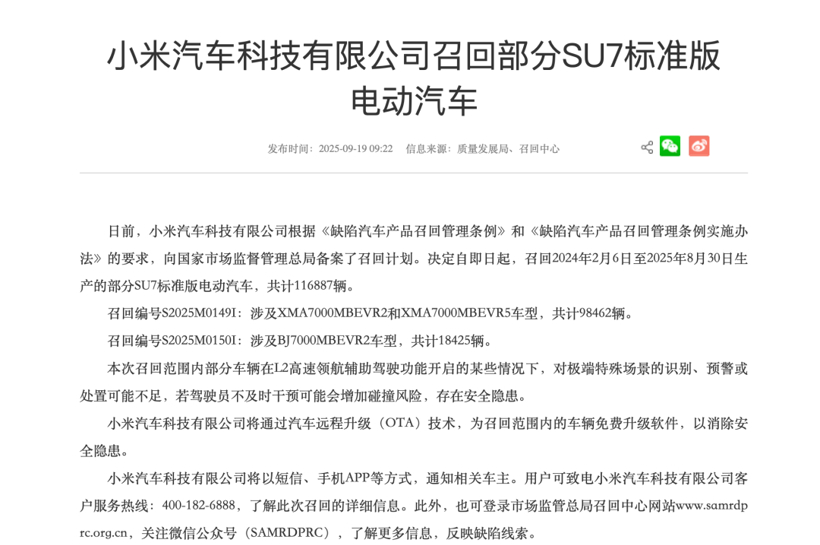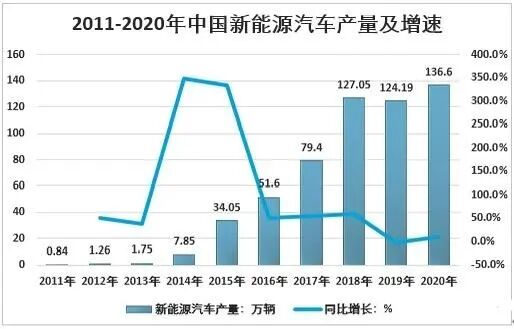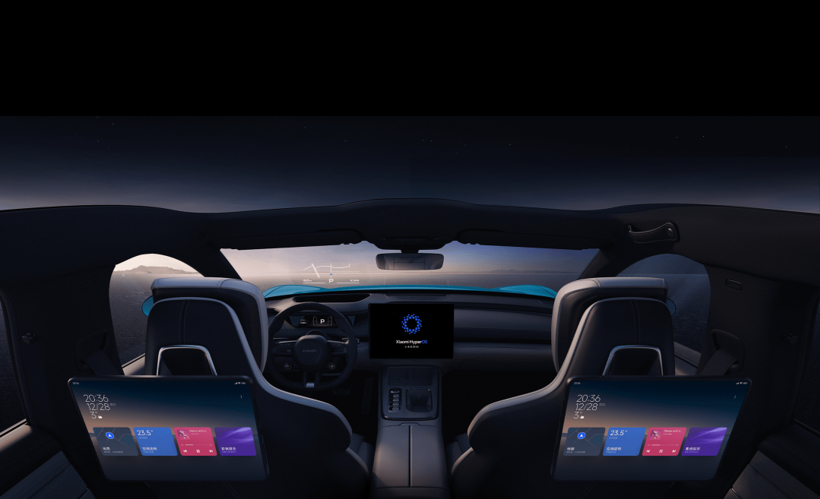What We Can See From Xiaomi's OTA Recall of 110,000 SU7 Units
Last week, a recall announcement issued by the State Administration for Market Regulation attracted widespread attention, as Xiaomi Auto announced the recall of a total of 116,887 SU7 standard version electric vehicles produced between February 6, 2024, and August 30, 2025, effective immediately.
According to the recall announcement, the reason for the recall is that "some vehicles, when the L2 highway navigation assistance function is activated, have insufficient ability to recognize, warn, or handle extremely special scenarios. If the driver does not intervene in time, it may increase the risk of collision, constituting a safety hazard." Contrary to the traditional perception of many long-established consumers, the recall method used this time is the OTA recall, which has become more standardized and frequently used in the past two years.

A few details are worth noting.
The recall involves over 110,000 units of the Xiaomi SU7 model, all of which are the standard version. The SU7 Pro and Max models are not affected. Based on the proportion, this likely includes all standard version models sold since the launch.
Based on this inference, the OTA recall for the highway pilot-assisted driving function is mainly for the upgrade of the Xiaomi Pilot Pro used only in the standard model of Xiaomi SU7. Correspondingly, the SU7 Pro and Max models use Xiaomi HAD.
In terms of computing power, the standard version still uses a single NVIDIA Orin chip with a computing power of only 84 TOPS. However, the SU7 Pro and Max models use two NVIDIA Orin X chips, with a total computing power of 508 TOPS. In addition, the SU7 Pro and Max models are also equipped with Hesai's 128-line LiDAR.
Another detail is that although it is clear that this upgrade is initiated due to the high-speed navigation assist driving function, the specific reason for the upgrade seems more like a "software upgrade" rather than a "product defect." Therefore, it was chosen to use the OTA method to quickly complete the upgrade in a short period of time.
Xiaomi Motors responded that this OTA upgrade recall aims to further enhance the reliability of the assisted driving function, including optimizing the speed control strategy for assisted driving and adding dynamic speed features, making the high-speed navigation assistance function more coherent. Xiaomi Motors always prioritizes user safety as the first principle. Although this upgrade does not require any physical replacement of parts, it is still managed and filed according to recall procedures.
We are already very familiar with OTA for mobile phones, and OTA for the in-car experience functions is also very common. However, many users are not yet familiar with using OTA as a remote upgrade technology. Why can OTA also be considered a "vehicle recall"?
In fact, this OTA recall by Xiaomi is not an isolated case. In 2024, there were a total of 233 vehicle recalls implemented in China, involving 11.237 million vehicles. Among them, automakers conducted 19 remote upgrade (OTA) recalls, affecting 4.068 million vehicles, representing a 246.8% increase compared to the previous year.
In 2020, the State Administration for Market Regulation issued the "Notice on Further Strengthening the Supervision of Automotive Over-the-Air (OTA) Technology Recalls," which for the first time explicitly included OTA technology in the recall regulatory system. It requires that any elimination of product defects or implementation of recalls through OTA must be filed with the regulatory authorities.
At that time, the sales of new energy vehicles in our country had exceeded 1.36 million, with models equipped with OTA functions accounting for approximately 23.7%. Mid to high-end models regarded OTA upgrades as a core feature. However, there was a general tendency in the industry to emphasize functionality iteration while overlooking safety regulation.

Some car manufacturers have repackaged software defect fixes as "function optimizations," quietly addressing safety hazards under the guise of routine OTA upgrades. They neither report to regulatory authorities nor clearly inform users of the risks. This "implicit recall" not only deprives users of their right to know but also leaves the safety risks posed by software defects out of control.
In this context, the regulatory notice of 2020 established the core principle of "filing system," requiring enterprises that eliminate product defects and implement recalls through OTA methods to submit complete filing materials to the market regulatory authorities before initiating the upgrade.

In February this year, the Ministry of Industry and Information Technology issued a notice on further strengthening the management of access, recall, and software online upgrades for intelligent connected vehicle products. It clearly stipulates that OTA upgrade activities involving vehicle autonomous driving functions must obtain the corresponding permits in accordance with relevant access management regulations. Enterprises carrying out OTA upgrade activities to eliminate vehicle product defects and implement recalls must organize and implement them in accordance with the "Measures for the Implementation of the Regulations on the Management of Defective Automobile Product Recalls," further strengthening the supervision of OTA recalls.
Since the policy breakthrough in 2020, China's OTA recall regulatory policies have continuously advanced. This forward-looking layout not only provides a safety boundary for the innovation of the new energy vehicle industry but also standardizes the OTA recall process, allowing users to enjoy technological convenience while gaining more robust safety assurance. Although no physical parts replacement is required, Xiaomi still strictly follows the filing procedures of the "Regulations on the Administration of Recall of Defective Automobile Products," which is a result of the integration of OTA into recall supervision by the State Administration for Market Regulation in 2020.

On the other hand, as intelligent driving technology gradually permeates more vehicle models today, many car manufacturers quickly launch brand new intelligent driving software to seize the timeliness of technology and market opportunities. Some issues and shortcomings are left to be gradually upgraded through OTA in the future.
In mid-August this year, the State Administration for Market Regulation and the Ministry of Industry and Information Technology drafted a consultation paper titled "Notice by the State Administration for Market Regulation and the Ministry of Industry and Information Technology on Strengthening the Supervision and Management of Recalls and Production Consistency of Intelligent Connected New Energy Vehicle Products and Normative Promotion." This notice explicitly mentions "strictly implementing the classification management requirements for OTA upgrade activities and not concealing defects through OTA."
This also means that in order to cope with the unique environment of the current automobile market and the multiple upgrades that can be carried out under OTA, relevant national departments will do their utmost to fulfill their regulatory obligations, preventing car manufacturers from using the idea of OTA upgrades to allow unreliable products to enter the market.
In the era of smart cars, software has become a core safety element. The traditional hardware recall model is difficult to adapt to the rapid iteration characteristics of software, while OTA technology provides an efficient path for defect repair. This rapid iteration without the need to replace hardware is not only responsible for user safety but also significantly reduces upgrade costs and saves upgrade time. Automotive OTA upgrades represent regulatory recognition of the safety that can be achieved through software upgrades. This shift compels automakers to enhance their safety verification capabilities and establish a more transparent user communication mechanism. Just as Xiaomi Auto provides detailed explanations of technical details and emphasizes the principle of safety first, this is key to gaining user trust.
【Copyright and Disclaimer】The above information is collected and organized by PlastMatch. The copyright belongs to the original author. This article is reprinted for the purpose of providing more information, and it does not imply that PlastMatch endorses the views expressed in the article or guarantees its accuracy. If there are any errors in the source attribution or if your legitimate rights have been infringed, please contact us, and we will promptly correct or remove the content. If other media, websites, or individuals use the aforementioned content, they must clearly indicate the original source and origin of the work and assume legal responsibility on their own.
Most Popular
-

List Released! Mexico Announces 50% Tariff On 1,371 China Product Categories
-

EU Changes ELV Regulation Again: Recycled Plastic Content Dispute and Exclusion of Bio-Based Plastics
-

Case Study | Clariant AddWorks™ Additives Solve Plastic Yellowing Problem
-

Mexico officially imposes tariffs on 1,400 chinese products, with rates up to 50%
-

Wanhua Chemical Transforms Annual Production of 60,000 Tons PBAT Facility to Produce PETG






